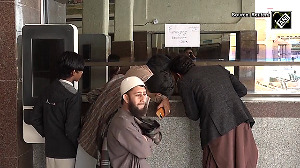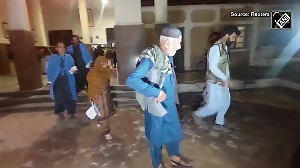 Why does the army remain embroiled in counter-insurgency, denying itself a peace dividend even after expending blood and treasure in imposing calm?
Why does the army remain embroiled in counter-insurgency, denying itself a peace dividend even after expending blood and treasure in imposing calm?
Two recent newspaper articles join issue over whether the army is opportunistically expanding its role in Jammu & Kashmir because of New Delhi’s failure to initiate political dialogue with the state.
Shekhar Gupta argued in the Indian Express (‘Disarming’ Kashmir, December 7) that political stasis in New Delhi had effectively given the army a veto on Kashmir policy. This permitted the generals to scuttle essential political gestures like revocation of the Armed Forces Special Powers Act, though militancy was practically dead in the valley.
Gupta suggests the army is empire-building, provocatively recounting: “In the past five years, the army has built more new golf courses and guest houses in Kashmir than the number of encounters it's had to fight.” He says the army must give the Kashmiri people a peace dividend by curtailing operations in populated areas, and focus instead on the Line of Control with Pakistan, where complacency has set in.
Four days later, the same newspaper published a counterview (‘Victory’ in the Valley, December 11) by Lieutenant General Syed Ata Hasnain, until last year the army’s top general in Kashmir. Rebutting Gupta, Hasnain says the army is guided by a clear politico-military aim that it formulated in the absence of a political directive from New Delhi. He terms Gupta’s declaration of victory “premature”, since Kashmir remains vulnerable to a jihadi influx from Afghanistan after Nato’s drawdown next year.
While active militancy has abated, many surrendered terrorists live in the Valley, writes Hasnain. With government promises to them still unfulfilled, violence could recur. He says the army cannot hand over responsibility to the civilians because nobody in J&K can yet take on that role. Dismissing critics of the army as “armchair strategists”, Hasnain urges: “Learn to trust your army -- it is your army.”
There is common ground in these two viewpoints. Both agree New Delhi has failed to articulate a political vision for J&K; and to issue a strategic directive that specifies security objectives for the army. Hasnain reveals, “(T)here has never been a clearly stated political aim given to the security forces (in Kashmir).” He says not even a military aim has been spelt out in Kashmir.
Gupta and Hasnain primarily disagree on whether improved security in J&K allows the army to withdraw from a central role and restore power to the state administration. Gupta says the army should step back since terrorists “have been roundly defeated”. Hasnain straddles both sides of the argument, admitting there is peace today but arguing that success must be gauged not by today’s calm but tomorrow’s potential chaos. Demanding “a realistic assessment of the future”, Hasnain evokes the “imponderables” of post-2014 Afghanistan. Peace, he seems to argue, requires not just the elimination of every last militant today but also certainty that no more would arrive tomorrow.
Not every general favours such caution. Lieutenant General Rustom Nanavatty, the hugely respected former commander of the northern army, believes the army must know when its mission has been accomplished in counter-insurgency operations. In his recent book, Internal Armed Conflict in India, Nanavatty points out: ‘(N)o government can, simultaneously, claim a ‘vastly improved security situation on the ground’, and persist with an unaltered military presence and unchanged methods in the conduct of military operations. Continuing with military operations on the same size, scale, pattern and intensity as before makes a mockery of such claims.’
Why, then, does the army remain embroiled in counter-insurgency, denying itself a peace dividend even after expending blood and treasure in imposing calm? There is little evidence to support allegations that the army has a vested interest in keeping the pot boiling in J&K -- such as awards, promotions and loosely monitored intelligence budgets. The more likely reason, as Hasnain suggests, is that the army fears civilian incompetence might fritter away its hard-won gains, reviving terrorism and requiring the army to do the job all over again.
Hasnain is on stronger ground in arguing that confining the army to the LoC carries operational risks because roads leading to the border areas run through the big towns, making these vulnerable to interdiction. The army has, in fact, already handed over law and order duties in population centres to the state and central police. But it insists on retaining AFSPA for dealing with any disruption of these lifelines.
“To win army support for relaxing AFSPA, or for partial demilitarisation, the state and central government must convince the army of their ability to control the state and maintain security,” says Nanavatty.
The key question then is: When can the state administration provide acceptable security in J&K? Kashmir’s politicians, bureaucrats and security agencies have ceded centrestage to the army for two decades, creating a highly militarised security environment. The generals will always oppose any dilution of security powers since the army focuses on hard risks, not ephemeral political benefits. New Delhi, which has always dealt with J&K more as a security problem than a political one, has no wish to assume the risks inherent in reducing the army’s profile.
The potential downside -- a resurgence of militancy -- is daunting, while the upside -- six Lok Sabha seats -- is small change. So the UPA fires the gun from the army’s shoulder by allowing the generals to “veto” AFSPA. Remember, little heed is paid to the army in crucial matters like equipment modernisation, operational preparedness and the need for tri-service command.
Hasnain would raise eyebrows with his suggestion that the army was assuming political policy. He writes, ‘In 2011, we enunciated our own joint politico-military aim for our commanders -- ‘integrate Jammu and Kashmir with mainstream India, politically, economically, socially and psychologically’.’
The army lacks the mandate and resources to execute this broad aim, which clearly encroaches into the realm of politics and governance. Even so, this is not political meddling but the response of a goal-oriented military to a policy vacuum -- it simply steps in and assumes the role. A plethora of civil-military scholars like Samuel Finer and Amos Perlmutter have documented this phenomenon extensively. In the scrupulously apolitical Indian Army, this is not cause for alarm. Yet, a farsighted political leadership would look to create the political, administrative and security environment needed for reducing the army’s role in Kashmir.
Hasnain makes his most questionable argument almost in passing. He says the Rashtriya Rifles -- some 40,000-50,000 soldiers, organised into counter-insurgency units -- must never be disbanded, though the RR was sanctioned in the 1990s as a temporary force for counter-insurgency. Hasnain wants RR battalions to be treated as regular army units, since Pakistan’s Frontier Corps militia, which operates in the tribal areas along the Afghanistan border, are capable of fighting alongside the Pakistan Army.
Adding more and more battalions may have benefited a 19th century army, but would be a grave disservice to the modern-day Indian Army. With an unsustainable chunk of the army’s budget already going on manpower, and with 100,000 additional soldiers being added for defending the China border, numbers must be pared to leave funds for equipment modernisation.











 © 2025
© 2025